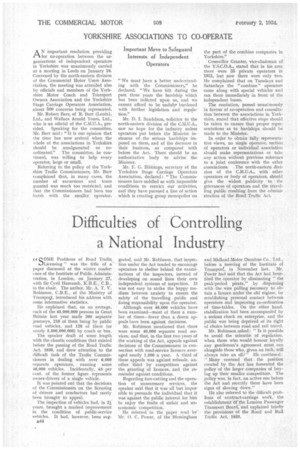Difficulties of Controlling a National Industry
Page 58

If you've noticed an error in this article please click here to report it so we can fix it.
re COME Problems of Road Traffic "JLicensing " was the title of a' paper discussed at the winter conference of the Institute of Public Administration, in London, on January .27, with Sir Cyril Hurcomb, X.B.E., C.I3., in the chair. The author, Mr. A. T. V. Robinson, C,B.E., of the Ministry of Transport, introduced his address with some informative statistics.
He explained that, on an average, each of the 45,000,000 persons in Great Britain last year made 260 separate journeys, 210 of them being by public road vehicles, and 120 of these (or nearly 5,500,000,000) by coach or bus.
The speaker dealt at some length with the chaotic conditions that existed before the passing of the Road Traffic Act, 1930, and drew attention to the difficult task of the Traffic Commissioners in dealing with over 6,000 separate operators, running some 46,000 vehicles. Incidentally, 43per cent. of the former figure represents owner-drivers of a single vehicle.
It was pointed out that the decisions of the Commissioners on the licensing of . drivers and conductors had rarely been brought to appeal. The inspection of vehicles had, in 21 years, brought a marked improvement in the 'condition of public-service vehicles. It bad, however, been sug B4-1
gusted, said Mr. Robinson, that inspecs tion under the Act tended to encourage operators to shelter behind the examinations of the inspectors, instead of developing on sound lines their own independent systems of inspection. It was not easy to strike the happy medium between anxiety to ensure the safety of the travelling public and fixing responsibility upon the operator.
Although over 46,000 vehicles have been examined—most of them a number of timesfewer than a dozen appeals have been against decisions.
Mr. Robinson mentioned that there were some 40,000 separate road services, and that, in the first two years of the working of the Act, appeals against decisions of the Commissioners in connection with road-service licences averaged nearly 1,500 a year. A third of these appeals was against refusals, another third by competitors against the granting of licences, and the remainder against conditions.
Regarding fare-cutting and the operation of unnecessary services, the speaker said that it wasall but impossible to persuade the individual that it was against the public interest for him to enjoy the fruits of unfair and uneconomic competition.
He referred to the paper read by Mr. 0. C. Power, of the Birmingham
and Midland MotorOmnibus Co., Ltd., before .a Meeting of the Institute of Transport, in November last, Mr. Power had said that the Act had benefited the operator by elhninating "the peak-period pirate," by dispensing with the wire pulling necessary to obtain a licence under the old regime, by establishing personal contact between operators and improving co-ordination of time-tables. On the other hand, sta.bilization had been accompanied by a serious check on enterprise, and the public was being deprived of its right of choice between road and rail travel.
Mr. Robinson asked: " Is it possible to avoid the minutim of regulation. when those who would honour loyally any gentleman's agreement must run alongside those who, given an inch, will always take an ell?" He continued: ". Many contend that the position created by the Act has fomented the policy of the larger companies of buying up their smaller competitors. The policy was, in fact, an active one before the Act and recently there have been signs of slowing dOwn." • •. '
He also referred to the difficult problems of contract-carriage work, the establishment Of the London Passenger Transport Board, and explained briefly the provisions of the Road and Rail Traffic Act, 1933.




























































































